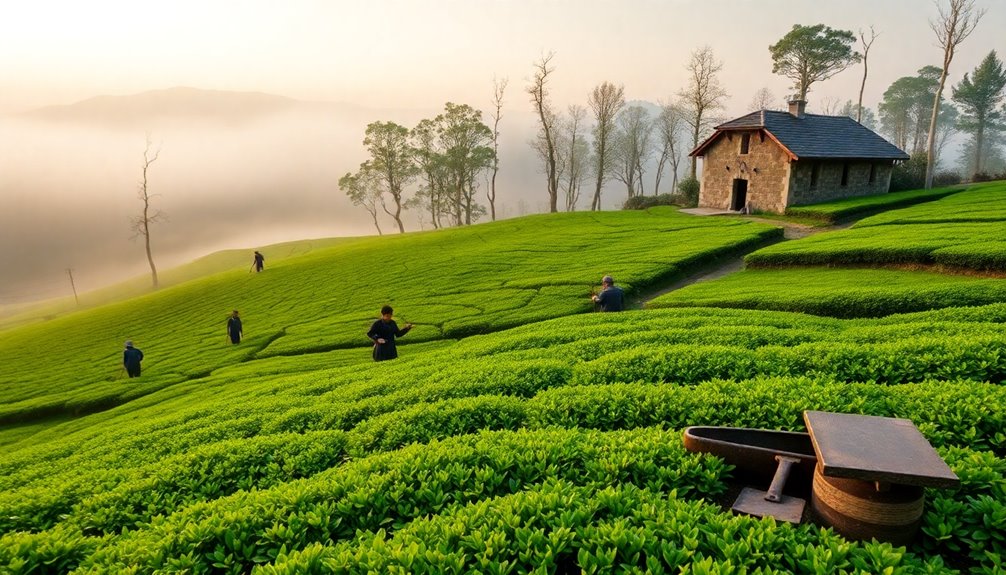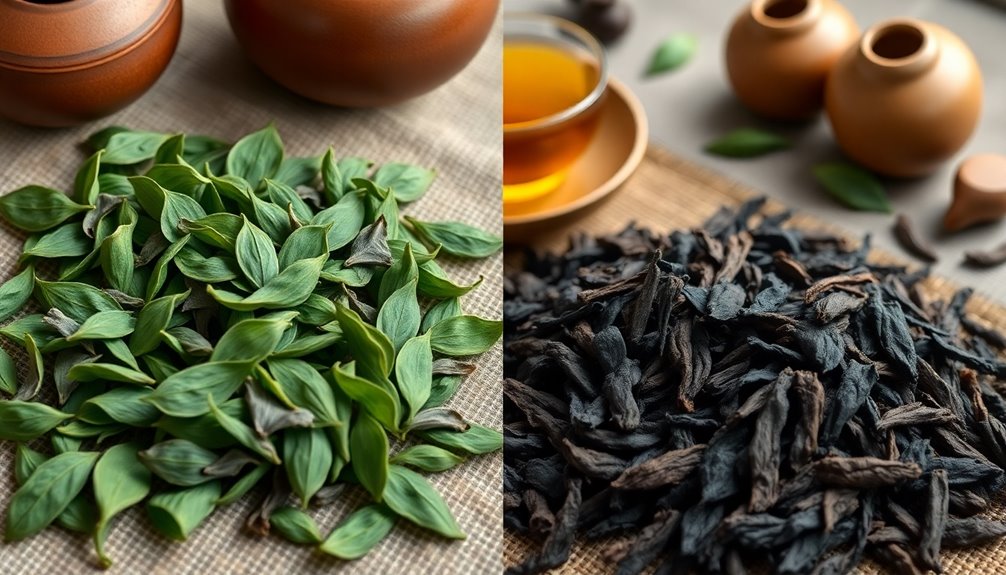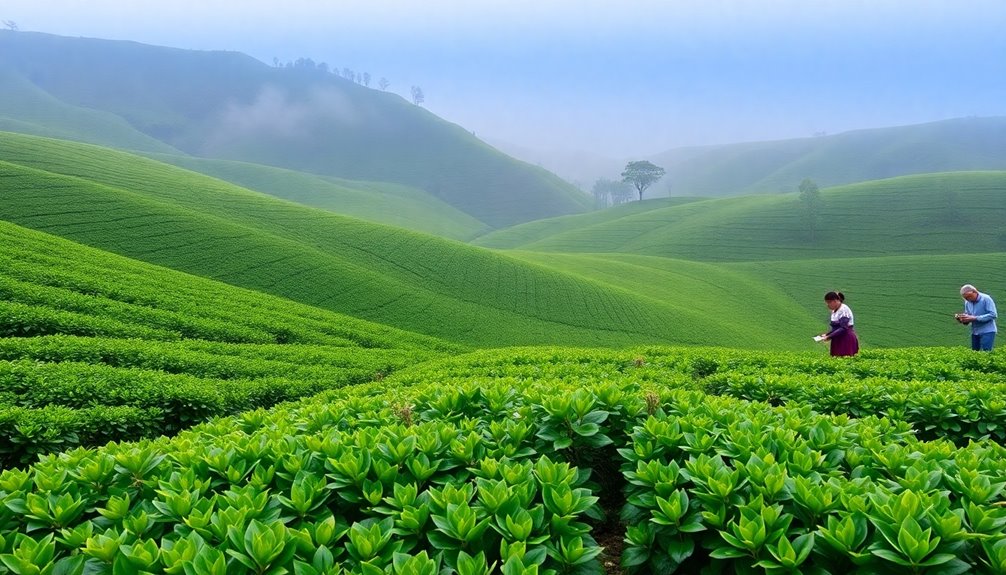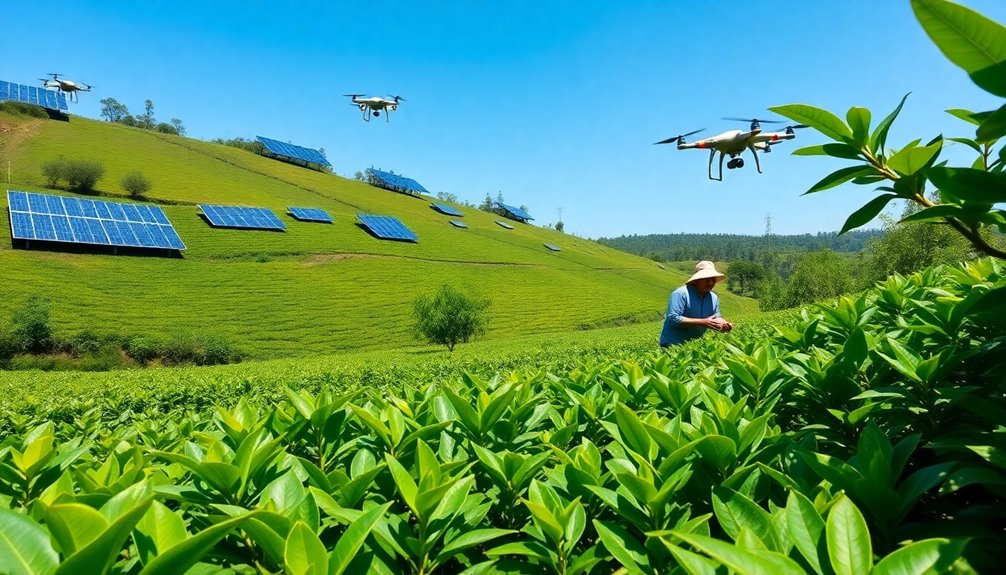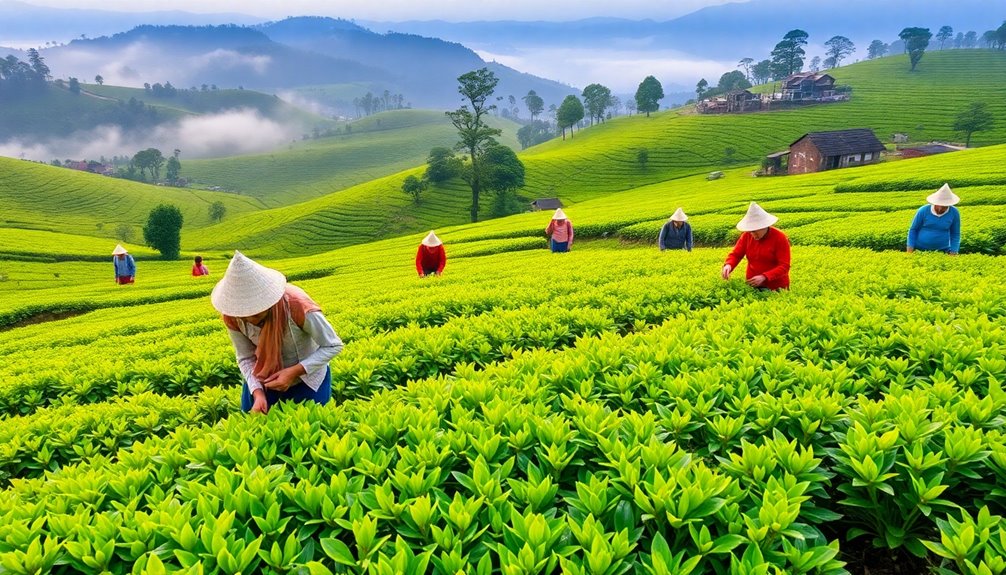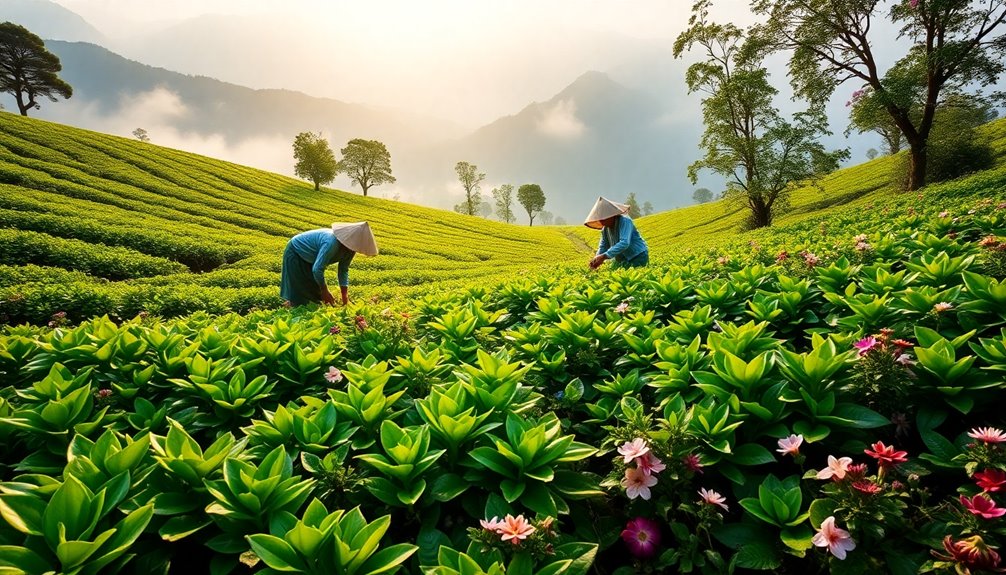Exploring ancient techniques of tea production is super exciting! It all started thousands of years ago in China when Emperor Shen Nong discovered tea. People boiled leaves into a medicinal porridge back then. Over time, methods improved, with loose-leaf tea becoming popular during the Tang Dynasty. Unique ceremonies like Gongfu in China and Chanoyu in Japan highlight tea's cultural importance. Different regions also have their special ways of preparing tea, which show their traditions. By learning about these ancient practices, you can appreciate your next cup of tea even more, and there's so much fun history to explore!
Key Takeaways
- Tea was initially prepared by boiling leaves into a medicinal porridge, as discovered by Emperor Shen Nong around 2737 B.C.E.
- The Tang Dynasty introduced whole-leaf infusion methods, marking a significant evolution in tea processing.
- The Three Kingdoms Period led to the creation of tea cakes, blending tea leaves with rice milk for unique flavors.
- Lu Yu's "The Classic of Tea" in the Tang Dynasty outlined essential processing steps still referenced today.
- Regional variations, such as those from the Jino people, showcase diverse ancient techniques and cultural heritage in tea production.
Introduction
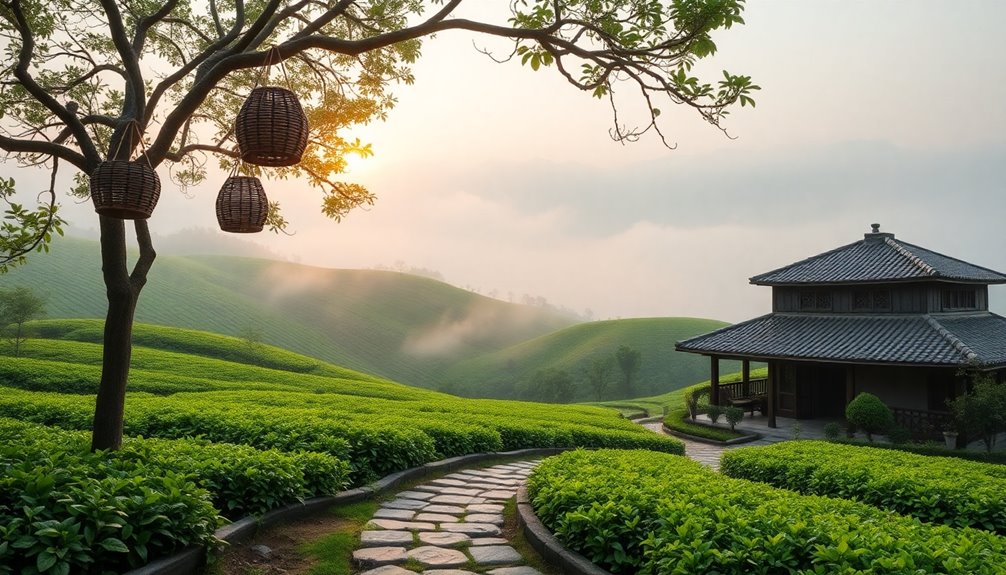
Tea production techniques have evolved dramatically since their inception, transforming a simple medicinal infusion into a global beverage staple. Imagine ancient Chinese times, around 2737 B.C.E., when Emperor Shen Nong discovered tea. He found that boiling tea leaves created a thick porridge, believed to have healing powers. This was just the beginning of tea's exciting journey!
As time passed, the brewing methods changed. During the Tang Dynasty, people began using whole tea leaves, steaming and roasting them to create delicious loose-leaf teas. This laid the groundwork for the wonderful flavors we enjoy today.
By the time of the Song Dynasty, tea culture blossomed, and everyone was eager to embrace new ways of brewing tea.
The introduction of pulverizing and infusing techniques during the Three Kingdoms Period led to the creation of tea cakes, which were made from leaves and rice milk. This innovation set the stage for future methods.
As we explore the rich history of tea production, you'll see how these ancient practices shaped our modern tea traditions. Get ready to dive into a world of flavors and aromas that have delighted people for centuries!
Historical Tea Processing Methods
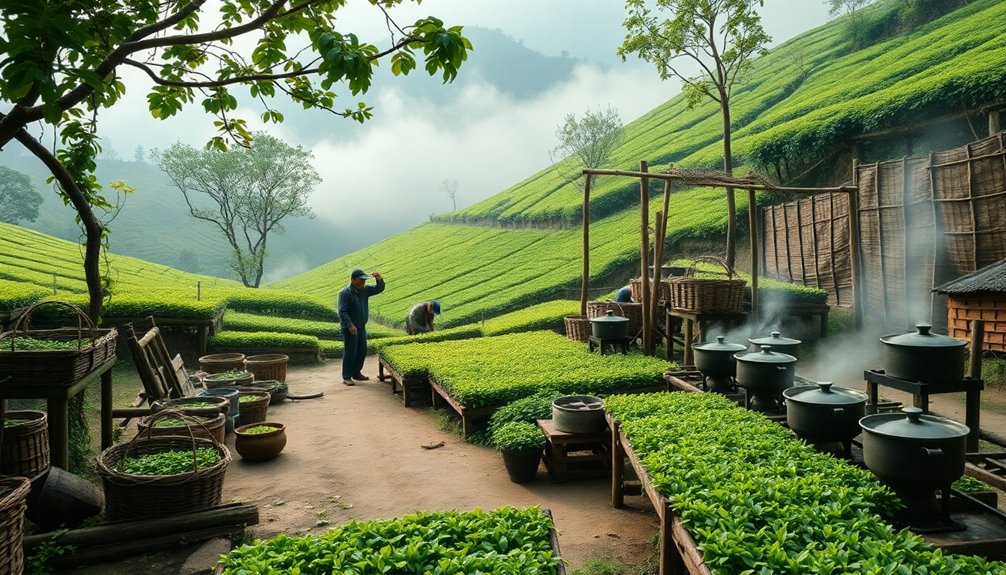
Over the centuries, tea processing methods have undergone significant transformations that greatly influenced how the beverage is enjoyed today.
In ancient times, people boiled fresh leaves to make tea, like the Jino people of Yunnan who even created tea porridge!
During the Three Kingdoms Period, a new method emerged. They started pulverizing the leaves and infusing them, leading to the creation of tea cakes.
Things changed even more during the Tang Dynasty. Lu Yu's book, "The Classic of Tea," described important steps for tea processing, like withering, steaming, and drying, which boosted tea quality.
Fast forward to the Yuan and Ming Dynasties, and you'll notice a shift from tea cakes to loose leaf tea. This change made it easier to enjoy the rich flavors and aromas!
Cultural Significance of Tea Rituals
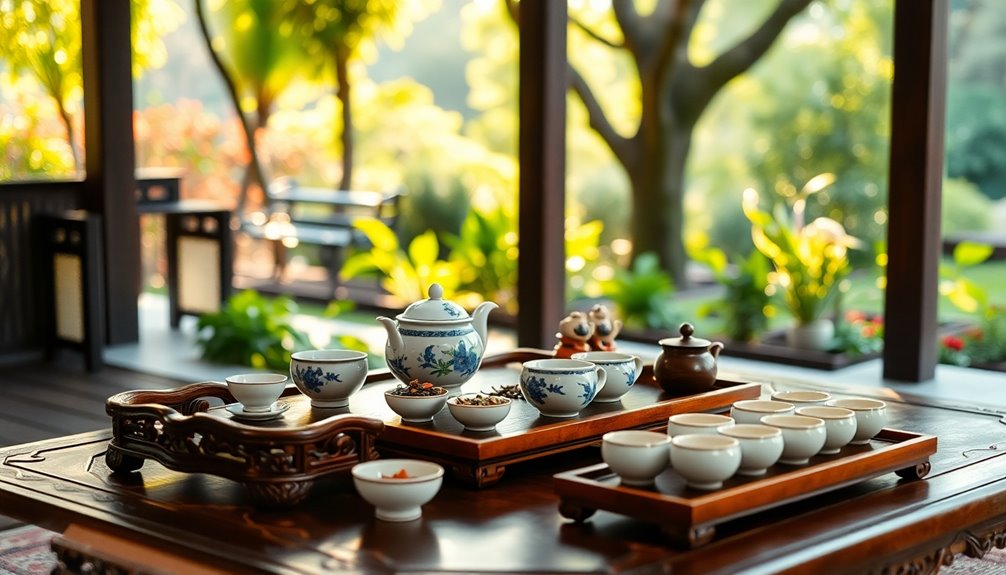
The cultural significance of tea rituals goes beyond mere beverage consumption; they embody traditions that connect people and communities. In many cultures, sharing traditional tea is a way to show hospitality and strengthen bonds. For example, during tea gatherings, friends and family come together to enjoy each other's company, creating lasting memories.
In China, the Gongfu tea ceremony showcases precision and skill. Tea experts perform this art form with great care, turning tea preparation into a beautiful experience.
Similarly, the Japanese tea ceremony, or Chanoyu, emphasizes mindfulness and aesthetics, reflecting Zen principles. Each movement is thoughtful, creating a serene atmosphere.
Historical texts like Lu Yu's "Classic of Tea" reveal the deep respect people have for tea. It's not just a drink; it's intertwined with poetry and philosophy.
The evolution of tea rituals also shows how adaptable tea can be. Whether it's a formal ceremony or a casual cup shared among friends, the essence of tea remains the same: it's about community and connection.
Regional Variations in Processing
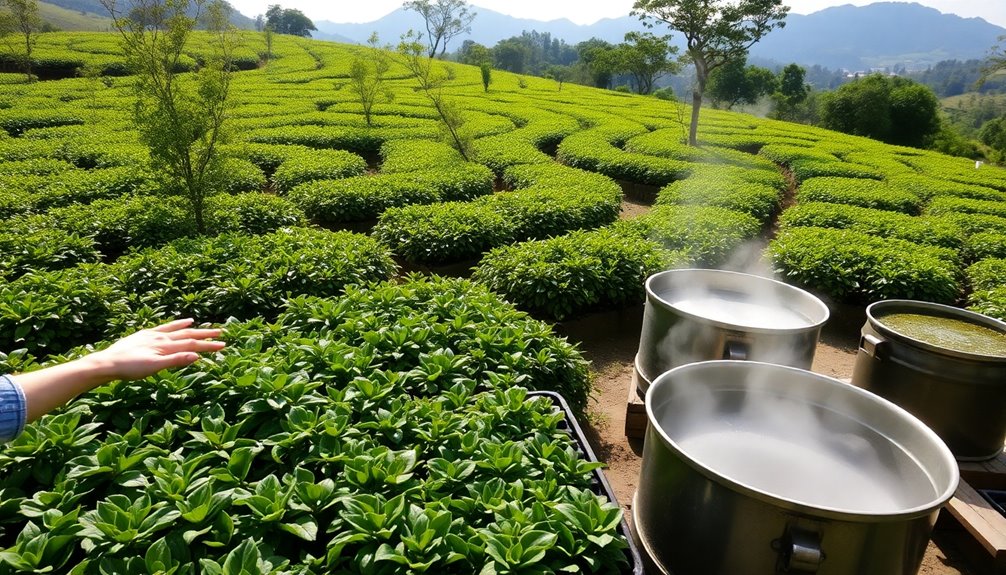
Across the globe, different regions showcase unique tea processing techniques that reflect their cultural heritage and local resources.
For instance, the Jino people in Yunnan continue to use traditional methods, pounding fresh tea leaves into a paste with seasonings. This creates a special dish that highlights a regional variation in tea preparation.
In East China, they boil tea leaves to make a delicious tea porridge, showing an early culinary use of tea that's different from just brewing it.
During the Three Kingdoms Period, people started making tea cakes using pulverizing-infusing techniques, mixing tea leaves with rice milk. This innovation added to the rich tea culture.
The Tang Dynasty popularized whole-leaf infusion, steaming and roasting the leaves, leading to the creation of various loose-leaf teas that became popular in later dynasties.
Cultural Appropriation in Tea Practices
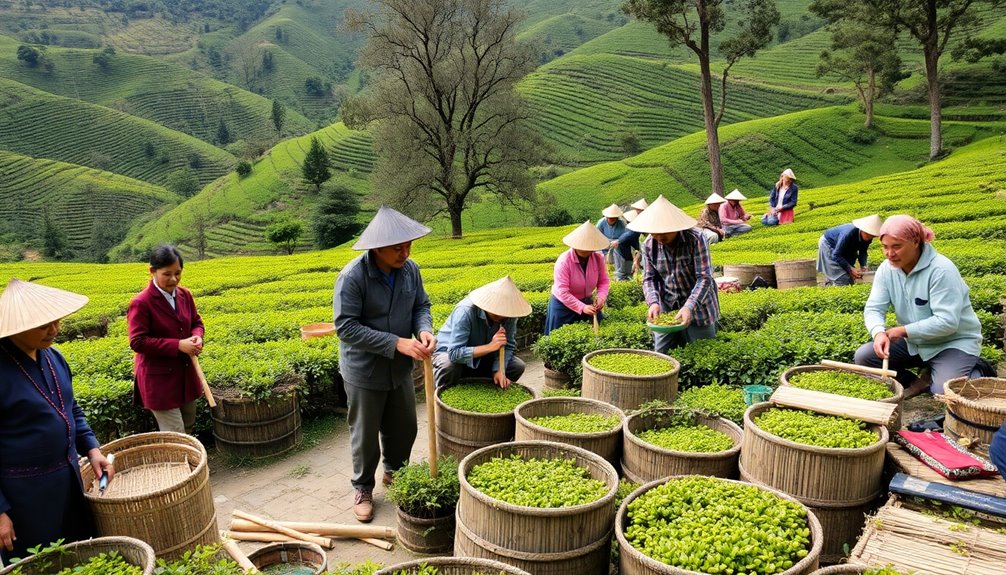
Tea processing techniques reflect not only regional variations but also the cultural significance behind them. When you explore tea practices, you might notice cultural appropriation can happen. This occurs when elements of traditional tea ceremonies, like the Gongfu tea ceremony or the Japanese Tea Ceremony, are adopted without proper respect for their origins.
These rituals are more than just making tea; they carry deep historical significance and reflect the identities of communities, such as the Chinese and Japanese. For example, the Chaozhou Gongfu emphasizes mindful tea practices, celebrating the beauty and flavor of the tea.
Unfortunately, in Western markets, tea culture can become commercialized, diluting these meaningful traditions. You might find that some adaptations oversimplify these rich practices, missing out on their true essence.
To prevent cultural appropriation, it's important to understand the historical roots and significance of the teas you enjoy. Engaging with authentic tea producers helps you respect the traditions passed down through generations.
Practical Applications
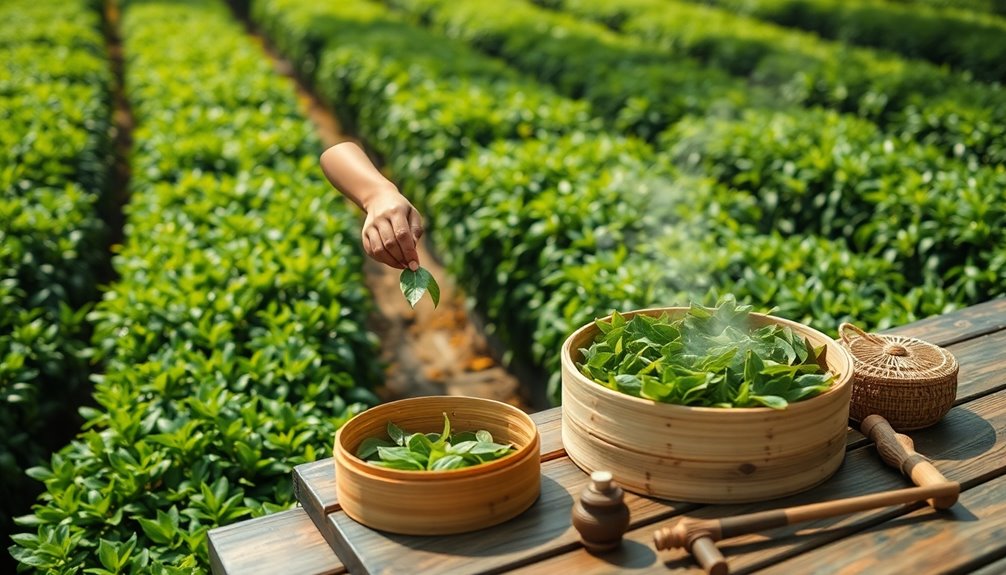
Many enthusiasts appreciate the practical applications of traditional tea production techniques, as they enhance the overall tea experience. The history of tea is rich and filled with fascinating methods. For instance, during the Tang dynasty, whole-leaf infusion became popular, allowing tea lovers to enjoy the full flavor of the leaves. This method has evolved, leading to the highly welcomed loose tea we enjoy today.
You can explore these ancient techniques in your own tea-making adventures. Try using fresh, high-quality tea leaves and experiment with different brewing times. Each method, from the decoction technique to modern tea innovations, offers unique flavors and aromas. Additionally, incorporating ingredients like turmeric and ginger can enhance the health benefits of your tea experience.
Chinese legends often highlight the art and tradition behind tea, making your tea time feel special and meaningful. Incorporating these practices into your routine can create a joyful experience.
Whether you're sipping iced tea on a hot day or enjoying a warm cup of brewed loose tea, you're connecting with a tradition that spans centuries. So, dive into the world of tea, and let the flavors tell you their stories!
Frequently Asked Questions
What Are the Techniques of Tea Production?
When you explore tea production techniques, you'll discover methods like decoction, pulverizing-infusing, and whole-leaf infusion. Each technique enhances flavor and quality, leading to various tea types like green, black, oolong, and pu-erh.
How Did Ancient People Make Tea?
Ancient people made tea by boiling leaves for medicinal brews, then later ground and mixed them with rice milk. Over time, they developed steaming and roasting methods, enhancing flavors and creating distinct tea styles.
What Are the 4 Main Stages of the Production of Tea?
The four main stages of tea production are withering, oxidation, rolling, and drying. Each step's vital for developing flavor and aroma, ensuring you enjoy a rich and unique tea experience in every cup.
What Is the Origin of Tea Production?
Tea production traces back to southwest China around 2737 B.C.E. when Emperor Shen Nong discovered it by chance. Over centuries, it evolved from medicinal uses to a beloved beverage, shaping cultures worldwide.
Conclusion
In exploring the ancient techniques of tea production, you've discovered a world rich with history and culture. Each method tells a story, connecting people and traditions. From the way tea leaves are picked to the rituals that surround its enjoyment, there's so much to learn and appreciate. So, whether you sip a comforting cup at home or share a pot with friends, remember that every cup of tea has a tale waiting to be told!

